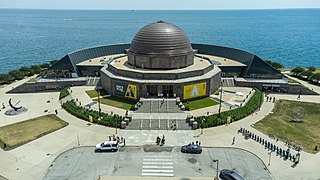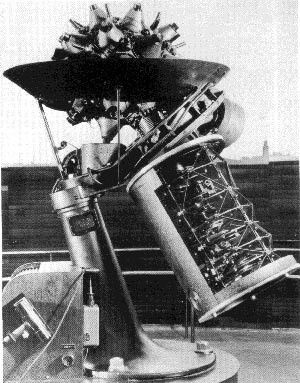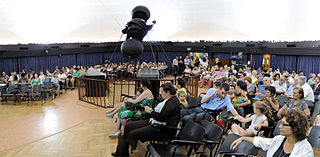
A planetarium is a theatre built primarily for presenting educational and entertaining shows about astronomy and the night sky, or for training in celestial navigation.

The Adler Planetarium is a public museum in Chicago, Illinois, dedicated to astronomy and astrophysics. It was founded in 1930 by local businessman Max Adler. Located on the northeastern tip of Northerly Island on Lake Michigan, the Adler Planetarium was the first planetarium in the United States. It is part of Chicago's Museum Campus, which includes the John G. Shedd Aquarium and The Field Museum. The Planetarium's mission is to inspire exploration and understanding of the universe.

Morehead Planetarium and Science Center is located on the campus of the University of North Carolina at Chapel Hill. As a unit of the university, Morehead receives about one-third of its funding through state sources, one-third through ticket and gift sales, and one-third through gifts and grants.

Stardome Observatory is a public astronomical observatory situated in Maungakiekie/One Tree Hill Domain in Auckland, New Zealand.

Griffith Observatory is an observatory in Los Angeles, California, on the south-facing slope of Mount Hollywood in Griffith Park. It commands a view of the Los Angeles Basin including Downtown Los Angeles to the southeast, Hollywood to the south, and the Pacific Ocean to the southwest. The observatory is a popular tourist attraction with a close view of the Hollywood Sign and an extensive array of space and science-related displays. It is named after its benefactor, Griffith J. Griffith. Admission has been free since the observatory's opening in 1935, in accordance with the benefactor's will.

The Fernbank Science Center is a museum, classroom, and woodland complex located in Atlanta. It is owned and operated by the DeKalb County School District, which announced in May 2012 it was considering closing the facility to cut its annual budget, then quickly shelved the plan after public outcry. The nearby Fernbank Museum of Natural History is a private non-profit organization that is separate from the Science Center.

The Roger B. Chaffee Planetarium, named for astronaut Roger B. Chaffee, was constructed in the early 1960s as part of the Public Museum of Grand Rapids. The facility initially featured a 30-foot (9.1 m) plaster dome and a Goto Optics mechanical star projector. Among the planetarium's first shows was "Star of Wonder", an astronomical attempt at an explanation of the Star of Bethlehem. The show received positive reviews in the Grand Rapids area and remained in the Chaffee's catalogue for several years.

A Zeiss projector is one of a line of planetarium projectors manufactured by the Carl Zeiss Company. Main models include Copernican (1924), Model I (1925), Model II (1926), Model III (1957), Model IV (1957), Model V (1965), Model VI (1968), Spacemaster (1970), Cosmorana (1984), Skymaster ZKP2 (1977), and Skymaster ZKP3 (1993).
UNA Observatory is an astronomical observatory owned and operated by the University of North Alabama. It is located in Florence, Alabama (USA). It has 2 telescopes, a Celestron 0.35 m Schmidt–Cassegrain telescope. The UNA Planetarium is a 65-seat planetarium with a Spitz A3P projector and East Cost Control Systems controller.

The McLaughlin Planetarium is a former working planetarium whose building occupies a space immediately to the south of the Royal Ontario Museum in Toronto, at 100 Queen's Park. Founded by a grant from philanthropist Colonel R. Samuel McLaughlin, the facility was opened to the public on October 26, 1968. It had, for its time, a state-of-the-art electro-mechanical Zeiss planetarium projector that was used to project regular themed shows about the stars, planets, and cosmology for visitors. By the 1980s the planetarium's sound-system and domed ceiling were used to display dazzling music-themed laser-light shows. The lower levels of the planetarium contained a gallery called the "Astrocentre" that featured space-related exhibits, related artifacts on the history of astronomy and was also home of the world's first commercial Stellarium

A planetarium projector, also known as a star projector, is a device used to project images of celestial objects onto the dome in a planetarium.

The Rose Center for Earth and Space is a part of the American Museum of Natural History in New York City. The Center's complete name is The Frederick Phineas and Sandra Priest Rose Center for Earth and Space. The main entrance is located on the northern side of the museum on 81st Street near Central Park West in Manhattan's Upper West Side. Completed in 2000, it includes the new Hayden Planetarium, the original of which was opened in 1935 and closed in 1997. Neil deGrasse Tyson is its first and, to date, only director.

Armand Neustadter Spitz was an American planetarium designer.
Bryan-Gooding Planetarium in the Alexander Brest Science Theatre is a planetarium in the Museum of Science and History in Jacksonville, Florida, U.S. It was built in 1988 and featured a 60-foot-diameter (18 m) dome-shaped projection screen, JBL stereo sound system, and a Zeiss Jena Optical mechanical planetarium star projector. The facility has seating for 200, and approximately 60,000 people see a planetarium show each year.

The Galileo Galilei planetarium, commonly known as Planetario, is located in Parque Tres de Febrero in the Palermo district of Buenos Aires, Argentina.

B. M. Birla Planetarium is a large planetarium in Chennai, India. The fifth B. M. Birla planetarium in the country, it is located at Kotturpuram in the Periyar Science and Technology Centre campus which houses eight galleries, namely, Physical Science, Electronics and Communication, Energy, Life Science, Innovation, Transport, International Dolls and Children and Materials Science, with over 500 exhibits. Built in 1988 in the memory of the great industrialist and visionary of India B. M. Birla, it is considered the most modern planetarium in India, providing a virtual tour of the night sky and holding cosmic shows on a specially perforated hemispherical aluminium inner dome. Other Birla planetariums in India include the M. P. Birla Planetarium in Kolkata, the Birla Planetarium in Hyderabad, and the planetariums in Tiruchirapalli and Coimbatore.

The Birla Planetarium in Kolkata, West Bengal, India, is a single-storeyed circular structure designed in the typical Indian style, whose architecture is loosely styled on the Buddhist Stupa at Sanchi. Situated at Chowringhee Road adjacent to the Victoria Memorial, St. Paul's Cathedral and the Maidan in Central Kolkata, it is the largest planetarium in Asia and the second largest planetarium in the world. There are two other Birla Planetariums in India: B.M. Birla Planetarium in Chennai and the Birla Planetarium in Hyderabad.

Parkland College is a public community college in Champaign, Illinois. It is part of the Illinois Community College System serving Community College District 505 which includes parts of Coles, Champaign, DeWitt, Douglas, Edgar, Ford, Iroquois, Livingston, Moultrie, McLean, Piatt, and Vermilion Counties. Parkland College enrolls approximately 9,000 students annually, with more than 340,000 students served since September 1967.

Prague Planetarium is a planetarium located in Bubeneč, Prague, Czech Republic, next to the Stromovka park and Výstaviště Praha. Its dome is one of the largest in the world, measuring 23.5 m in a diameter. It was opened on November 20, 1960. It is equipped with both optomechanical and digital projectors.

The Professor Aristóteles Orsini Planetarium, also known as the Ibirapuera Planetarium, is a planetarium in Ibirapuera Park, São Paulo. It opened in January 1957, and was the first planetarium in Brazil and Latin America. It is one of three planetaria in São Paulo, with the others being Carmo Planetarium and the Johannes Kepler Planetarium at Sabina Escola Parque do Conhecimento.




















